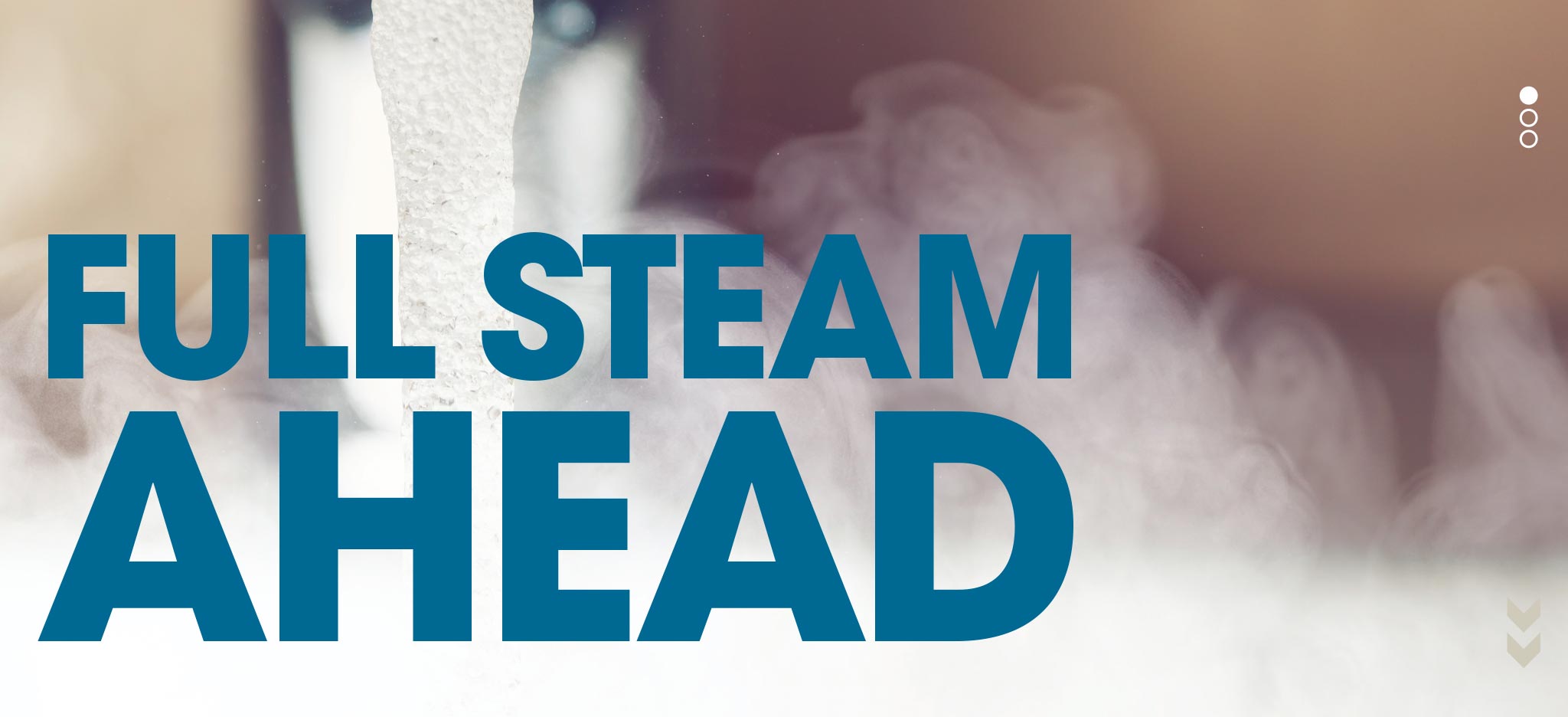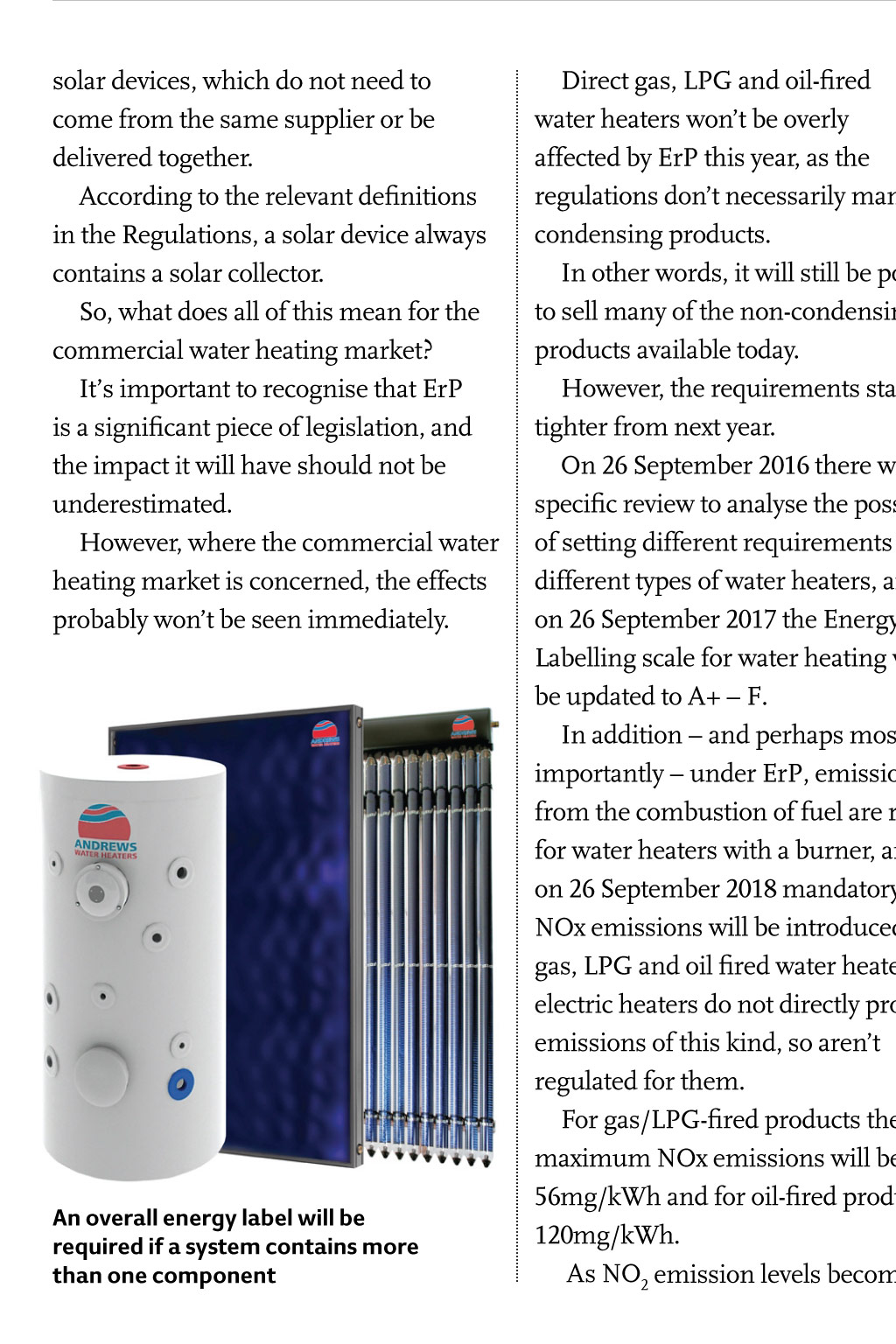














EU Legislation Water Heaters Full steam ahead Tough new European regulations on water heaters are nearly upon us. Designed to reduce energy use and NOx emissions, the new rules will impact both manufacturers and specifiers, says Jonathan Tedstone of Andrews Water Heaters S pecifications for water heaters are set to change markedly over the next four years, as new EU legislation aiming at reducing the energy use of products comes into force. In line with the EU Directive 2009/125/EC, from 26 September 2015, water heaters with a rated output of up to 400kW and hot water storage tanks with a storage volume of up to 2,000 litres will need to meet minimum energy performance criteria. Smaller systems with outputs of up to 70kW and storage volumes of up to 500 litres will require an energy label. In 2017, further energy efficiency requirements will be brought in, and in 2018 mandatory limits for NO2 emissions will be set. The directive, known as the ErP Directive, applies to energy-related products and is supported by the Energy Labelling Directive, which require products energy performance to be labelled under the Ecodesign scheme (Tap Read more button, right). Water heaters with a storage and instantaneous design: gas; LPG; oil and electric heaters; dual fuel heaters; solar thermal hot water products; and dedicated heat pump water heaters, are all included. The energy efficiency bands for water heating products will initially range from A to G, but will eventually extend to A+++, and band G will be removed in 2017. It is likely that conventional products will have an A-G (A-F from September 2017) classification, while A+, A++ and A+++ will be reserved for renewable technologies. As well as stating the energy efficiency band, product labels for water heaters and hot water storage tanks will also include a size (load) profile, ranging from 3XS to 4XL. For example: 3XS would be a water heater typically suitable for a small single basin at 35oC; S would be a shower and single basin at 35oC; M would be showers and a sink at 55oC; L would be a bath, shower and sink at solar devices, which do not need to come from the same supplier or be delivered together. According to the relevant definitions in the Regulations, a solar device always contains a solar collector. So, what does all of this mean for the commercial water heating market? Its important to recognise that ErP is a significant piece of legislation, and the impact it will have should not be underestimated. However, where the commercial water heating market is concerned, the effects probably wont be seen immediately. Direct gas, LPG and oil-fired water heaters wont be overly affected by ErP this year, as the regulations dont necessarily mandate condensing products. In other words, it will still be possible to sell many of the non-condensing products available today. However, the requirements start to get tighter from next year. On 26 September 2016 there will be a specific review to analyse the possibility of setting different requirements for different types of water heaters, and on 26 September 2017 the Energy Labelling scale for water heating will be updated to A+ F. In addition and perhaps most importantly under ErP, emissions from the combustion of fuel are relevant for water heaters with a burner, and on 26 September 2018 mandatory NOx emissions will be introduced for gas, LPG and oil fired water heaters electric heaters do not directly produce emissions of this kind, so arent regulated for them. For gas/LPG-fired products the maximum NOx emissions will be 56mg/kWh and for oil-fired products 120mg/kWh. As NO2 emission levels become more An overall energy label will be required if a system contains more than one component eoR RMade WHat eRP Means foR PRoduCt sPeCifiCation WHat eRP Means foR PRoduCt sPeCifiCation On 21 October 2009 the EU adopted the Directive 2009/125/EC: establishing a framework for the setting of ecodesign requirements for energyrelated products (ErP). Commonly referred to as the ErP Directive, it applies to energy-related products (defined as products that use energy, or do not use energy yet have an indirect impact on energy consumption) sold in the domestic, commercial and industrial sectors in the European Economic Area. There are dozens of product groups called Lots under scrutiny, and so far the focus has been on those that consume the largest proportion of natural resources and energy, and therefore have the most potential to reduce greenhouse gas emissions. The Energy Labelling Directive complements and works in conjunction with Ecodesign, with products being given an energy label based on a standard laboratory test regime. This type of labelling is already seen on domestic appliances such as fridges, freezers, TVs and washing machines. 55oC; XXL would be simultaneous baths and showers; and 4XL would be large volume applications for use in hotels or healthcare facilities. Additional performance and efficiency parameters will need to be conveyed via a technical fiche and within product data, which must be included on company websites and in installation instructions included with the product. If a number of components are installed as a system then an overall efficiency rating and customised package label will be required, but the individual products will still have specific labels. This has been introduced in order to provide better information to end-users, recognising that, as well as the individual components of an installation being important, combinations of products can also greatly increase efficiency. The manufacturer is responsible for providing product labels, but whoever supplies a package and processes the transaction known as the Dealer is always responsible for generating the package label and undertaking the necessary calculations. For the purpose of ErP, a waterheating package will contain one or more water heaters and one or more The Ecodesign and Energy Labelling Directives should be embraced; they will ensure only the most efficient water heaters and storage tanks are being manufactured stringent, we will see significant changes to the water heating market. In terms of product alterations, gas and LPG products dont pose any major R&D issues, but it will be relatively difficult for oil fired products to meet the new requirements without some redesign work or additional emission abatement technology. Further requirements about the energy efficiency of water heaters also start to apply from 26 September 2018, and a review of the Regulations is anticipated. The Ecodesign and Energy Labelling Directives should be embraced; they will ensure that only the most efficient water heaters and storage tanks are being manufactured, and will help specifiers and end-users to make more informed decisions. cJ JONATHAN TEDSTONE is category manager for Andrews Water Heaters